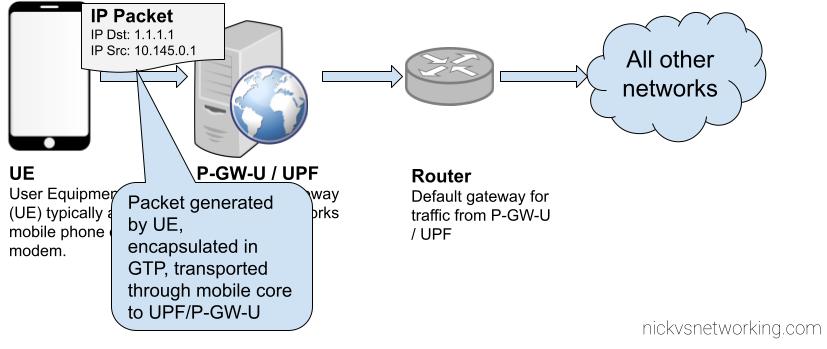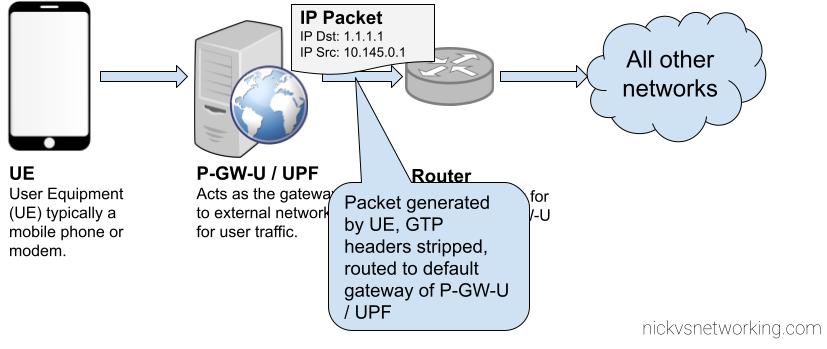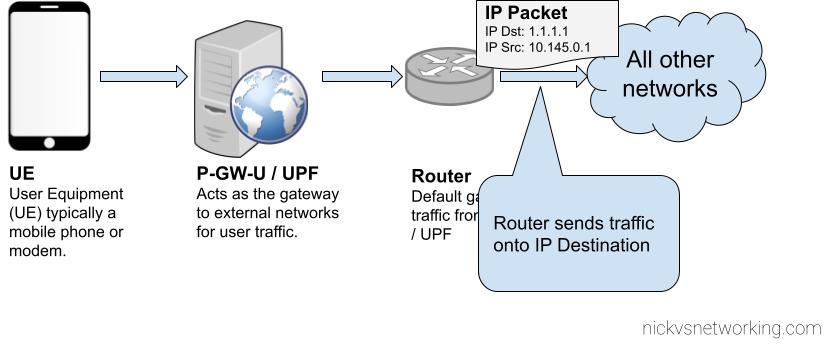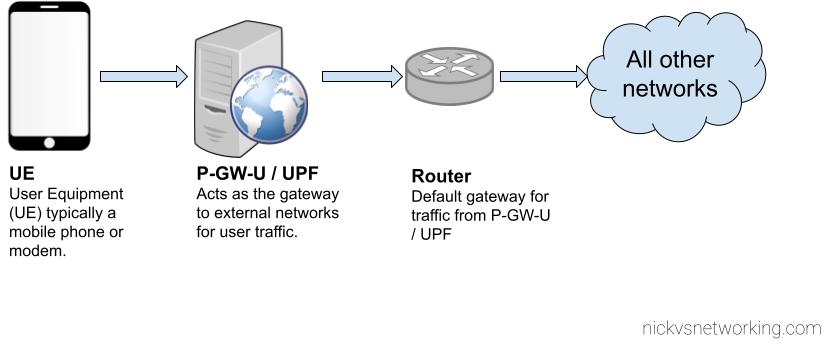While most users of Open5GS EPC will use NAT on the UPF / P-GW-U but you don’t have to.
While you can do NAT on the machine that hosts the PGW-U / UPF, you may find you want to do the NAT somewhere else in the network, like on a router, or something specifically for CG-NAT, or you may want to provide public addresses to your UEs, either way the default config assumes you want NAT, and in this post, we’ll cover setting up Open5GS EPC / 5GC without NAT on the P-GW-U / UPF.
Before we get started on that, let’s keep in mind what’s going to happen if we don’t have NAT in place,
Traffic originating from users on our network (UEs / Subscribers) will have the from IP Address set to that of the UE IP Pool set on the SMF / P-GW-C, or statically in our HSS.
This will be the IP address that’s sent as the IP Source for all traffic from the UE if we don’t have NAT enabled in our Core, so all external networks will see that as the IP Address for our UEs / Subscribers.

UE Generates packet 
Core Network transports GTP encapsulated traffic to P-GW-U / UPF 
UPF/P-GW-U routes the traffic to it’s default gateway
The above example shows the flow of a packet from UE with IP Address 10.145.0.1 sending something to 1.1.1.1.
This is all well and good for traffic originating from our 4G/5G network, but what about traffic destined to our 4G/5G core?
Well, the traffic path is backwards. This means that our router, and external networks, need to know how to reach the subnet containing our UEs. This means we’ve got to add static routes to point to the IP Address of the UPF / P-GW-U, so it can encapsulate the traffic and get the GTP encapsulated traffic to the UE / Subscriber.
For our example packet destined for 1.1.1.1, as that is a globally routable IP (Not an internal IP) the router will need to perform NAT Translation, but for internal traffic within the network (On the router) the static route on the router should be able to route traffic to the UE Subnets to the UPF / P-GW-U’s IP Address, so it can encapsulate the traffic and get the GTP encapsulated traffic to the UE / Subscriber.
Setting up static routes on your router is going to be different on what you use, in my case I’m using a Mikrotik in my lab, so here’s a screenshot from that showing the static route point at my UPF/P-GW-U. I’ve got BGP setup to share routes around, so all the neighboring routers will also have this information about how to reach the subscriber.

Next up we’ve got to setup IPtables on the server itself running our UPF/P-GW-U, to route traffic addressed to the UE and encapsulate it.
sudo ip route add 10.145.0.0/24 dev ogstun sudo echo 1 > /proc/sys/net/ipv4/ip_forward sudo iptables -A FORWARD -i ogstun -o osgtun -s 10.145.0.0/24 -d 0.0.0.0/0 -j ACCEPT
And that’s it, now traffic coming from UEs on our UPF/P-GW will leave the NIC with their source address set to the UE Address, and so long as your router is happily configured with those static routes, you’ll be set.
If you want access to the Internet, it then just becomes a matter of configuring traffic from that subnet on the router to be NATed out your external interface on the router, rather than performing the NAT on the machine.
In an upcoming post we’ll look at doing this with OSPF and BGP, so you don’t need to statically assign routes in your routers.

Dear Nick,
would you please take a look at this and give me some hints?
https://github.com/open5gs/open5gs/issues/1341#issuecomment-1047141741
Thanks
Best regards
You don’t indicate where 10.0.1.208 is located on your drawing or in your explanation.
It’s the next hop.
Hey Nick,
In your command `sudo iptables -A FORWARD -i ogstun -o osgtun -s 10.145.0.0/24 -d 0.0.0.0/0 -j ACCEPT` at the bottom, is -o osgtun a typo?
Thanks